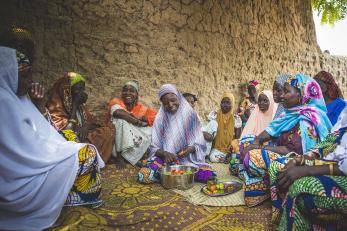Strengthening Social Cohesion for Violence Prevention
Ten Lessons for Policymakers and Practitioners

Download the summary two-pager ▸
Download the research brief ▸
Strengthening social cohesion is a cornerstone of many peacebuilding programs and other donor interventions in fragile and conflict-affected states. Yet the link between social cohesion and violence prevention is often assumed, not demonstrated, which frequently results in the conflation of social cohesion and peace outcomes. More evidence is needed on whether, when, and how improving social cohesion can help prevent conflict and build peace across different contexts.
Mercy Corps has spent the past decade conducting research on building social cohesion in various fragile and conflict-affected settings. This brief distills the evidence from these studies, along with the broader academic and policy literature, into ten lessons that respond to the most pressing questions policymakers and practitioners need answered to effectively invest in strengthening social cohesion for violence prevention. These questions, and the corresponding lessons, include:
What do we mean when we talk about social cohesion?
- Social cohesion is a set of values, identities, attitudes, and behaviors that help hold society together.
- Social cohesion has multiple dimensions – and they are not all correlated with each other.
How does weak social cohesion shape violence within and between communities?
- Building trust is central to reducing support for violence.
- Identity-based grievances can fuel support for violence, but shared identity and belonging can help lay the groundwork for peace.
- Civic engagement can help reduce support for violence, but it also poses risks.
- Interactions between groups can help reduce support for violence – particularly when those interactions are positive.
How can donors and practitioners help to build social cohesion in order to prevent violence?
- Creating opportunities for positive intergroup collaboration toward a shared goal is vital for building social cohesion.
- Interventions that strengthen the effectiveness and trustworthiness of local leaders can improve conflict management and reduce violence, regardless of whether they enhance intergroup trust.
- Interventions must account for gender-specific barriers to improving social cohesion.
- Violence prevention is more likely to be effective when programs have the flexibility to design activities to respond to context-driven diagnoses of social cohesion dynamics.
Forthcoming studies referenced in this brief:
- From High-Risk to Resilient: The Role of Social and Economic Interventions in Reducing Vulnerability to Violent Extremism in Kenya - March 2022
- Can Mediation Reduce Violence? The Effects of Negotiation Training for Local Leaders in North Central Nigeria - Spring 2022
- Mobilizing Communities to Build Social Cohesion and Reduce Vulnerability to Violent Extremism: Evidence from a Peacebuilding Program in Niger
- Social Cohesion and Violence in Africa - Spring/Summer 2022
- Understanding the Links Between Social Cohesion, Resilience, and Conflict in Mali- Summer 2022


